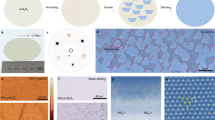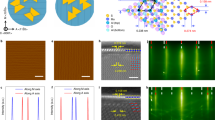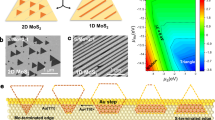Abstract
Two-dimensional (2D) semiconducting transition metal dichalcogenides (TMDs) represent the ultimate thickness for scaling down channel materials. They provide a tantalizing solution to push the limit of semiconductor technology nodes in the sub-1 nm range. One key challenge with 2D semiconducting TMD channel materials is to achieve large-scale batch growth on insulating substrates of single crystals with spatial homogeneity and compelling electrical properties. Recent studies have claimed the epitaxy growth of wafer-scale, single-crystal 2D TMDs on a c-plane sapphire substrate with deliberately engineered off-cut angles. It has been postulated that exposed step edges break the energy degeneracy of nucleation and thus drive the seamless stitching of mono-oriented flakes. Here we show that a more dominant factor should be considered: in particular, the interaction of 2D TMD grains with the exposed oxygen–aluminium atomic plane establishes an energy-minimized 2D TMD–sapphire configuration. Reconstructing the surfaces of c-plane sapphire substrates to only a single type of atomic plane (plane symmetry) already guarantees the single-crystal epitaxy of monolayer TMDs without the aid of step edges. Electrical results evidence the structural uniformity of the monolayers. Our findings elucidate a long-standing question that curbs the wafer-scale batch epitaxy of 2D TMD single crystals—an important step towards using 2D materials for future electronics. Experiments extended to perovskite materials also support the argument that the interaction with sapphire atomic surfaces is more dominant than step-edge docking.
This is a preview of subscription content, access via your institution
Access options
Access Nature and 54 other Nature Portfolio journals
Get Nature+, our best-value online-access subscription
$29.99 / 30 days
cancel any time
Subscribe to this journal
Receive 12 print issues and online access
$259.00 per year
only $21.58 per issue
Buy this article
- Purchase on Springer Link
- Instant access to full article PDF
Prices may be subject to local taxes which are calculated during checkout




Similar content being viewed by others
Data availability
The data from this study are available from the corresponding authors on reasonable request.
References
Liu, C. et al. 2D materials-based static random-access memory. Adv. Mater. 34, 2107894 (2022).
Wan, Y. et al. Wafer-scale single-orientation 2D layers by atomic edge-guided epitaxial growth. Chem. Soc. Rev. 51, 803–811 (2022).
Chubarov, M. et al. Wafer-scale epitaxial growth of unidirectional WS2 monolayers on sapphire. ACS Nano 15, 2532–2541 (2021).
Li, T. et al. Epitaxial growth of wafer-scale molybdenum disulfide semiconductor single crystals on sapphire. Nat. Nanotechnol. 16, 1201–1207 (2021).
Vlassiouk, I. V. et al. Evolutionary selection growth of two-dimensional materials on polycrystalline substrates. Nat. Mater. 17, 318–322 (2018).
Zhang, B. Y. et al. Hexagonal metal oxide monolayers derived from the metal–gas interface. Nat. Mater. 20, 1073–1078 (2021).
Tusche, C., Meyerheim, H. L. & Kirschner, J. Observation of depolarized ZnO(0001) monolayers: formation of unreconstructed planar sheets. Phys. Rev. Lett. 99, 026102 (2007).
Dong, J., Zhang, L., Dai, X. & Ding, F. The epitaxy of 2D materials growth. Nat. Commun. 11, 5862 (2020).
Devulapalli, V., Bishara, H., Ghidelli, M., Dehm, G. & Liebscher, C. H. Influence of substrates and e-beam evaporation parameters on the microstructure of nanocrystalline and epitaxially grown Ti thin films. Appl. Surf. Sci. 562, 150194 (2021).
Chen, T.-A. et al. Wafer-scale single-crystal hexagonal boron nitride monolayers on Cu (111). Nature 579, 219–223 (2020).
Wang, L. et al. Epitaxial growth of a 100-square-centimetre single-crystal hexagonal boron nitride monolayer on copper. Nature 570, 91–95 (2019).
Yang, P. et al. Epitaxial growth of centimeter-scale single-crystal MoS2 monolayer on Au(111). ACS Nano 14, 5036–5045 (2020).
Dumcenco, D. et al. Large-area epitaxial monolayer MoS2. ACS Nano 9, 4611–4620 (2015).
Yu, H. et al. Wafer-scale growth and transfer of highly-oriented monolayer MoS2 continuous films. ACS Nano 11, 12001–12007 (2017).
Aljarb, A. et al. Substrate lattice-guided seed formation controls the orientation of 2D transition-metal dichalcogenides. ACS Nano 11, 9215–9222 (2017).
Suenaga, K. et al. Surface-mediated aligned growth of monolayer MoS2 and in-plane heterostructures with graphene on sapphire. ACS Nano 12, 10032–10044 (2018).
Zhang, X. et al. Diffusion-controlled epitaxy of large area coalesced WSe2 monolayers on sapphire. Nano Lett. 18, 1049–1056 (2018).
Wang, Q. et al. Wafer-scale highly oriented monolayer MoS2 with large domain sizes. Nano Lett. 20, 7193–7199 (2020).
Toofan, J. & Watson, P. R. The termination of the α-Al2O3 (0001) surface: a LEED crystallography determination. Surf. Sci. 401, 162–172 (1998).
Chiang, Y.-M., Birnie, D. P. & Kingery, W. D. Physical Ceramics: Principles for Ceramic Science and Engineering (John Wiley & Sons, 1997).
Ji, Q. et al. Unravelling orientation distribution and merging behavior of monolayer MoS2 domains on sapphire. Nano Lett. 15, 198–205 (2015).
Yoshimoto, M. et al. Atomic‐scale formation of ultrasmooth surfaces on sapphire substrates for high‐quality thin‐film fabrication. Appl. Phys. Lett. 67, 2615–2617 (1995).
Pham Van, L., Kurnosikov, O. & Cousty, J. Evolution of steps on vicinal (0001) surfaces of α-alumina. Surf. Sci. 411, 263–271 (1998).
Thune, E., Fakih, A., Matringe, C., Babonneau, D. & Guinebretière, R. Understanding of one dimensional ordering mechanisms at the (001) sapphire vicinal surface. J. Appl. Phys. 121, 015301 (2017).
Koma, A. Van der Waals epitaxy for highly lattice-mismatched systems. J. Cryst. Growth 201–202, 236–241 (1999).
Lin, Y.-C. et al. Realizing large-scale, electronic-grade two-dimensional semiconductors. ACS Nano 12, 965–975 (2018).
Shi, Y. et al. Engineering wafer-scale epitaxial two-dimensional materials through sapphire template screening for advanced high-performance nanoelectronics. ACS Nano 15, 9482–9494 (2021).
Chen, L. et al. Step-edge-guided nucleation and growth of aligned WSe2 on sapphire via a layer-over-layer growth mode. ACS Nano 9, 8368–8375 (2015).
Fang, F. et al. Two-dimensional Cs2AgBiBr6/WS2 heterostructure-based photodetector with boosted detectivity via interfacial engineering. ACS Nano 16, 3985–3993 (2022).
Kresse, G. & Furthmüller, J. Efficient iterative schemes for ab initio total-energy calculations using a plane-wave basis set. Phys. Rev. B 54, 11169–11186 (1996).
Perdew, J. P., Burke, K. & Ernzerhof, M. Generalized gradient approximation made simple. Phys. Rev. Lett. 77, 3865–3868 (1996).
Blöchl, P. E. Projector augmented-wave method. Phys. Rev. B 50, 17953–17979 (1994).
Grimme, S., Antony, J., Ehrlich, S. & Krieg, H. A consistent and accurate ab initio parametrization of density functional dispersion correction (DFT-D) for the 94 elements H-Pu. J. Chem. Phys. 132, 154104 (2010).
Acknowledgements
J.-H.F. and V.T. are indebted to the financial support from the University of Tokyo and the Japan Society for the Promotion of Science (JSPS, 23H00253). V.T. is beholden to the support from the King Abdullah University of Science and Technology (KAUST) Office of Sponsored Research (OSR) under award CCF-3079 and Office of Technology Development under the RTF grant. L.-J.L. acknowledges support from the Jockey Club Hong Kong to the JC STEM lab of 3DIC and the Research Grant of the Council of Hong Kong (CRS_PolyU502/22). Y.W. and L.-J.L. acknowledge support from the University of Hong Kong and the National Key R&D Project of China (2022YFB4044100). J.-H.F. and V.T. acknowledge KAUST Core Labs and the National Synchrotron Radiation Research Center (NSRRC) for support for the STEM imaging and LEED characterization. Y.-J.L. acknowledges support from AS-CDA-108-M08 Academia Sinica. J.-H.F. and V.T. dedicate this work to Ibrahim Alnami, who passed away before completing this project.
Author information
Authors and Affiliations
Contributions
J.-H.F., L.-J.L. and V.T. conceived the project. J.-H.F. and H.S. restructured the c-plane sapphire and accomplished the AFM and cross-sectional STEM characterizations. J.-H.F., C.-K.C., Y.-M.C., C. Li, T.-H.L., Z.-S.J., I.A. and C.-C.T. synthesized the TMDs and carried out the Raman and photoluminescence characterizations. J.M., Y.W. and K.S. performed the first-principles calculations. C. Lin, C.-K.C., W.-H.C. and J.-H.F. executed the SHG analysis and LEED analysis. C.-K.C., W.-R.S., C.-S.L. and Y.-J.L. accomplished the fabrication and electrical characterization of MoS2 FETs. F.F., L.Z. and Y.S. synthesized and characterized the Cs2AgBiBr6 crystals. Q.W. conducted HRTEM and image analysis. W.-S.C. carried out LEED analysis. All the authors discussed and contributed to the results. J.-H.F., Y.W., L.-J.L. and V.T. wrote the paper.
Corresponding authors
Ethics declarations
Competing interests
The authors declare no competing interests.
Peer review
Peer review information
Nature Nanotechnology thanks Kibum Kang and the other, anonymous, reviewer(s) for their contribution to the peer review of this work.
Additional information
Publisher’s note Springer Nature remains neutral with regard to jurisdictional claims in published maps and institutional affiliations.
Supplementary information
Supplementary Information
Supplementary Figs. 1–12.
Rights and permissions
Springer Nature or its licensor (e.g. a society or other partner) holds exclusive rights to this article under a publishing agreement with the author(s) or other rightsholder(s); author self-archiving of the accepted manuscript version of this article is solely governed by the terms of such publishing agreement and applicable law.
About this article
Cite this article
Fu, JH., Min, J., Chang, CK. et al. Oriented lateral growth of two-dimensional materials on c-plane sapphire. Nat. Nanotechnol. 18, 1289–1294 (2023). https://doi.org/10.1038/s41565-023-01445-9
Received:
Accepted:
Published:
Issue Date:
DOI: https://doi.org/10.1038/s41565-023-01445-9
This article is cited by
-
3D integration of 2D electronics
Nature Reviews Electrical Engineering (2024)
-
Epitaxy of wafer-scale single-crystal MoS2 monolayer via buffer layer control
Nature Communications (2024)
-
Vapour-phase deposition of two-dimensional layered chalcogenides
Nature Reviews Materials (2023)
-
Batch fabrication of MoS2 devices directly on growth substrates by step engineering
Nano Research (2023)



